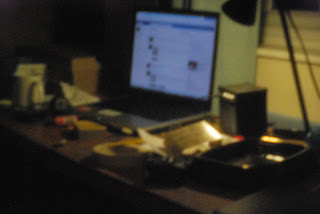I finally got round to converting one of my cameras into a classic pinhole camera! I've been wanting to do it for months now, but have never had the confidence to go ahead and experiment with film straight off with no pinhole experience, I figure it will be too expensive to get rolls and rolls of really bad photos developed at my not so local development lab thirty five miles away. They are worth the drive and I always make sure to drop in for a roll to be developed whenever I pop back home for a day. I have asked around and apparently there is absolutely no labs in this town who are actually any good. So I think I will continue to pay a premium and do it the hard way.
Since I really don't have the cash to afford my own (decent) DSLR, I have been in the habit of occasionally borrowing my uncle's Nikon D60, and if you ever read this uncy, thank you very much it's much appreciated! This camera has helped me attain a distinction for my art foundation course last year, it's become so useful in every bit of photography I have done. Wandering Blenheim Palace at night, skulking through old abandoned military air bases, and taking some amazing shots which aren't possible with my cameras. And I promise, one day I will buy my own!
But let's get down to business. I made a really simple, cheap, pinhole 'lens' for the nikon. I guess you can call it a lens even though it has no plastic or glass lens. It's just a hole in a body cap I bought for about £3 from ebay, and it arrived next day which I was super pleased with. I simply drilled a 4mm hole through the centre of the specially bought body cap, and sanded down the surface to make sure it was as flat as possible. Then, the trick is to get some aluminium foil, and some form of needle, and just lightly press down to make the smallest of holes in the thin metal of the foil. The hole was so small I couldn't actually see it with my naked eye. Flip the body cap over, then use black electrical tape to secure it into position over the bigger 4mm hole. Next whack the modified body cap on the camera and start shooting! Obviously a tripod and lengthy exposures are needed.
This is what it looks like, a beautiful bit of home DIY:
Now it was time to start experimenting with my new pinhole camera, the beauty of digital cameras means I can see my results straight away, rather than waiting for the roll of film to be developed. This is exactly why I started by converting a DSLR, because you can see the results straight away and during the process, learn about the specifics and delicate maths involved with taking photos this way. Below is the very first photograph I took, and yes, it isn't very good! The hole wasn't right, so I made a new one from a fresh piece of foil, and taped that on and carried on shooting.
You can see here I am starting to achieve some warmer colours and a characteristically soft focus feel you get from pinhole cameras
A few more tweaks with exposure lengths, yes I was doing it all by guesswork. Well, educated guesswork, because where's the fun in getting in bang on the first time?
So I shoved the camera on a tripod, and started taking 30 second exposures of the workspace in my room. I stuck at 30 seconds exposures for a time, since that's as long as the nikon will leave the shutter open. Of course, with the Bulb setting you can expose for as long as you like, but since I didn't have a remote shutter release at the time, and my hand isn't steady enough to hold the shutter down for 5 minutes without shaking and causing huge blur, I decided against the Bulb setting and stuck with just 30 seconds exposure times.
Notice the extremely soft focus feel and the colours which are beginning to emerge from the images, and the beautiful yellow glow from artificial light in the room. These images are starting to come together, and I am starting to understand how the pinhole system works. These are a great start to what I'm sure is going to be a long obsession with pinhole photography.







No comments:
Post a Comment